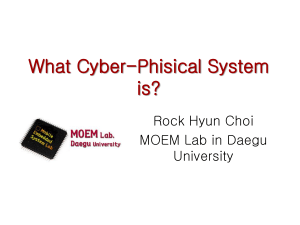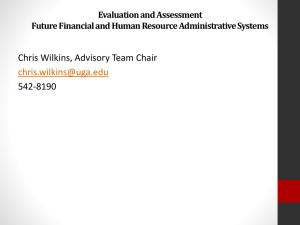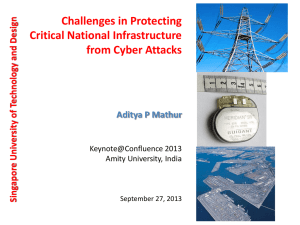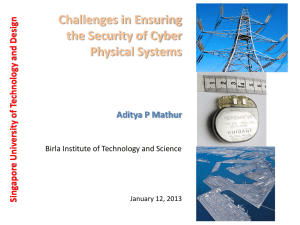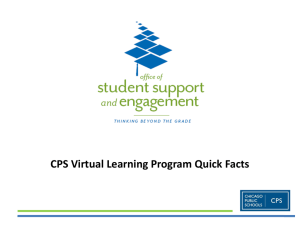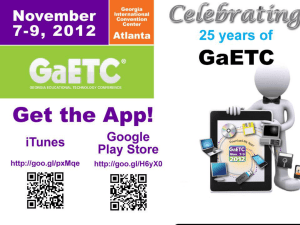Cyber physical systems: security and safety
advertisement
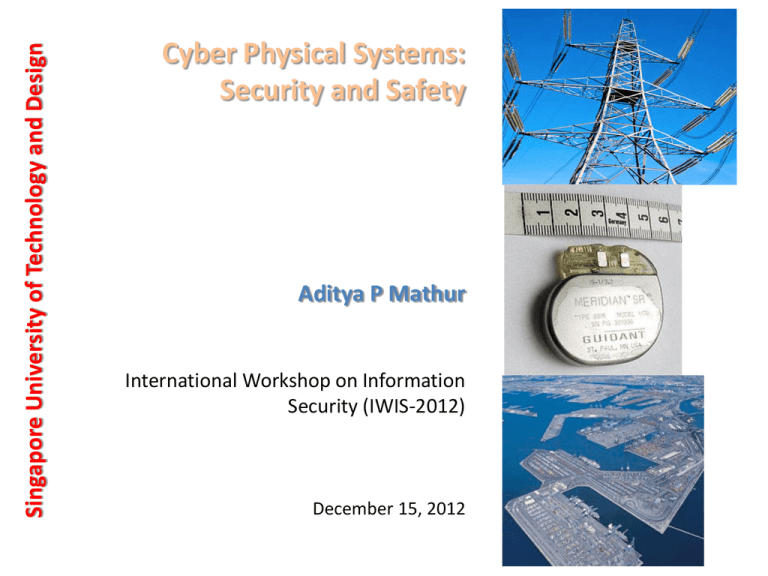
Singapore University of Technology and Design
Cyber Physical Systems:
Security and Safety
Aditya P Mathur
International Workshop on Information
Security (IWIS-2012)
December 15, 2012
Questions of interest
What is a CPS?
What are the security issues in CPS and how do they differ
from those in traditional information systems?
To what extent can a CPS be secured against cyber crime?
Are there some fundamental design principles that ought to
be used when designing or upgrading a CPS?
What are the curricular ramifications of CPS security?
2
Coverage
CPS examples and concerns, components, abstraction, incidents
Traditional versus CPS security
Industrial control systems
Two real-life incidents: Toys and Iran
Control systems: basics
Case studies: Medical devices and Irrigation Systems
CPS: design principles, research and educational needs
3
Cyber Physical Systems: Examples
4
Shipping
Several countries and cities in the world have some of
the world's busiest ports and large transshipment
hubs.
For example, PSA Singapore Terminals are connected
by 200 shipping lines to 600 ports in 123 countries,
with daily sailings to every major port of call in the
world.
5
Healthcare
Singapore offers Asia's best healthcare system, and its
standard of medical practice ranks among the best in
the world.
The Joint Commission International (JCI) has
accredited 11 hospitals and three medical centers in
Singapore.
6
Infocomm
Singapore today ranks as the second most networkready country in the world and the first in Asia,
according to the World Economic Forum's Global
Information Technology Report 2010/2011.
7
Energy
“Today, Singapore is the undisputed oil hub in Asia and
is one of the world’s top three export refining
centers....”
8
What
is
a
Smart
Grid?
Smart Grid - Overview
• Smart Grid : Overlay electrical grid with sensors (phasor monitoring
units - PMUs) and control systems (SCADA) to enable:
– reliable and secure network monitoring, load balancing, energy
efficiency via smart meters, and integration of new energy sources
Smart Grid – Smart Metering
Smart Metering Privacy Issue (1)
Smart Metering Privacy Issue (2)
Privacy
is
not
Secrecy!
Privacy is not Secrecy
• Privacy: the ability to prevent unwanted transfer of information (via
inference or correlation) when legitimate transfers happen.
• But privacy is not secrecy!
• Privacy problem: disclosing data provides informational utility while
also enabling potential loss of privacy
– Every user is potentially an adversary
– Encryption is not a solution!
?= Eve
Privacy
vs.
Secrecy!
Privacy versus Secrecy
• Privacy: the ability to prevent unwanted transfer of information (via
inference or correlation) when legitimate transfers happen.
• But privacy is not secrecy!
• Secrecy Problem: Protocols and primitives clearly distinguish a
malicious adversary vs. intended user and secret vs. non-secret
data.
– Encryption may be a solution.
Possible Solutions
• Robust Smart Metering Design with privacy
constraints
• Utility-Privacy Tradeoff Design
• Privacy Invasion Detection/Prevention
• Data masking
• Data Anonymisation
Other Potential Concerns:
16
CPS Vulnerability
Are your energy, healthcare, water, shipping,
transportation systems vulnerable to network attacks?
What, if any, are the vulnerabilities in such systems?
When exploited, how might such vulnerabilities affect
people?
17
CPS Control systems
Are the control systems in your large and critical CPSs
systems robust enough to withstand deception
attacks?
Are these control systems programmed to
withstand denial of service attacks?
18
Surviving from Physical attacks
• What happens if we lose
part, or even most of the
computing systems?
• Will redundancy alone
solve the problem?
• How to measure and
quantify of resilience of
current systems?
• How to ensure high
availability of CPS?
19
Defending Against Device Capture Attack
• Physical devices in CPS
systems may be captured,
compromised and released
back by adversaries.
• How to identify and
ameliorate the system
damage with trusted
hardware but potentially
untrusted/modified
software?
20
Real-Time Security in CPS
• CPS often requires realtime responses to
physical processes
• Little Study on how
attacks affect the realtime properties of CPS
• How to guarantee realtime requirements under
attack?
21
Concurrency in CPS
• CPS is concurrent in
nature, running both
cyber and physical
processes
• Little research on
handling large-scale
concurrent systems
22
Collaboration and Isolation
• CPS needs to effectively
isolate attackers while
maintaining collaborations
among different, distributed
system components
• How to avoid cascading
failures while minimizing
system performance
degradation?
23
Cyber Physical System: Components
24
CPS: Greenhouse
Temperature
sensor
Green house
Fan actuator
Network
Controller
25
CPS: Blending process
26
CPS Other examples
Pacemaker
ICD (Implantable Cardiovascular Defibrillator)
Insulin pump
Neuro-stimulators
27
Cyber Physical Systems: Abstraction
28
CPS: Component view
29
CPS: Systems View
x: state
Physical System
Actuator
Sensor
y
u: input
Control System
Estimation and control
: Network
30
CPS Network-based Attacks
Physical System
Actuator
u’ not u
controller
compromised
Sensor
Control System
y’ not y:
Sensor
compromised
Network
jammed
31
Existing Techniques
Authentication
Digital signatures
Access control
Intrusion detection
32
Enhancement of existing approaches
How deception and DoS attacks affect application layer
performance (e.g., estimation and control)?
Intrusion detection and deception attacks in control
systems?
What if a human is not in the loop for intrusion detection?
33
CPS incident statistics
34
CPS incident databases
BCIT Industry security incident databaseTOFINO
http://www.tofinosecurity.com/
Wurldtech: http://www.wurldtech.com/
Cyber incidents involving control systems, Robert Turk,
October 2005, Idaho National Laboratory, INL/EXT-05-00671
http://www.tofinosecurity.com/blog/2012-scada-securitypredictions-how-did-eric-byres-do
35
Sample CPS incidents
Over 500 SCADA vulnerabilities found in 2011
2010: Stuxnet [http://www.tofinosecurity.com/stuxnetcentral]
2010: Night Dragon, Duqu, Nitro
Nov 2012: kAndyKAn3 worm attacks North Pole Toys
36
CPS incident report statistics
Empirical Analysis of publicly disclosed ICS vulnerabilities since
2001” by Sean McBride
37
CPS incident (more) statistics
42% of all incidences were conducted by means of mobile
malware
61% of the perpetrators originated from external sources
43% of perpetrators were malware authors
38
Traditional versus CPS security
39
Traditional
Confidentiality: Ability to maintain secrecy from
unauthorized users.
Integrity: Trustworthiness of data received; lack of this leads
to deception.
Availability: Ability of the system being accessible
40
CPS
Timeliness: responsiveness, freshness of data
Availability: unexpected outages
Integrity: genuine data displayed and received by the controller
Confidentiality: Information regarding SCADA not available to
any unauthorized individual
Graceful degradation
Ref: A Taxonomy of Cyber Attacks on SCADA Systems, Zhu et al., UC Berkeley.
41
Industrial Control Systems
42
SCADA
Supervisory Control and Data Acquisition System
It is an industrial control system that consists of RTUs,
PLCs, and HMIs to control an industrial process.
Use: Manufacturing, power generation, fabrication,
oil and gas pipelines, etc.
43
RTU
Microprocessor controlled Remote
Terminal/Telemetry Unit
Interface between physical objects and a SCADA.
Transmits telemetry data to SCADA. Example: water
quality.
Siemens LC150
Pump Control
Telemetry Unit
44
PLC
Programmable Logic Controller
A computer to control the operation of electromechanical devices such as pumps, motors, switches
Hard real-time system
Programs stored in non-volatile memory, battery backup
Programmed using State Logic, Basic, C:
IEC 61131-3 programming standard
Siemens S7-mEC
embedded
controller
45
PLC Programming
Programs stored in non-volatile memory, battery backup
Programmed using IEC 61131-3 programming standard
Languages: graphical (e.g., Ladder diagram) and textual
(e.g., Structured Text, Sequential Function Charts)
Ref: http://www.rtaautomation.com/iec61131-3/
http://www.dogwoodvalleypress.com/uploads/excer
pts/03192005214421.pdf
46
PLC Ladder Logic Diagram
Rung 1
Rung 2
Rung 3
Timer, counter,
sequencer etc.
47
PLC Ladder Logic Example
Pilot light PL2 is to be ON when selector switch SS2 is
closed, push-button PB4 is closed and limit switch LS3 is
open.
Series connection
PL2=SS2 (AND) PB4 (AND) LS3
48
PLC Scan
PLC program is scanned continuously while reading the state
of physical inputs and setting the state of the physical outputs.
Scan time for one cycle is between 0-200ms.
Larger scan times might miss transient events.
49
HMI
Human Machine Interface
Operator panel to display and control of system/device
state
Programming software: Example: WinCC from Siemens
50
SDR
Software Defined Radio
Radio communication system that has the traditional hardware
components implemented in software. These include mixers,
filters, amplifiers, modulator/demodulator, etc.
51
Network Security in CPS: Siemens Approach
Use the notion of “cell protection.”
Divide plant network into “automation cells.” Inside
such a cell all devices are able to communicate with
each other.
Access is controlled at the entrance to each cell using
a hardware device
Communication with the outside world is via VPNprotected channel.
52
CPS Survivability
Despite these techniques, systems continue
to be compromised.
How can a CPS continue to function above a given
threshold in the presence of attacks?
53
Two stories:
North Pole Toys
Stuxnet
54
North Pole Toys: Basics
On-line retailer.
Carries specialized toys generally not found elsewhere.
Process: Toy Assembly, Toy Packaging and Toy Shipping
2011: Replaced the old manufacturing system with new
automated industrial control system.
Files are carried on USB sticks from main server to the
workshop; air gap established
55
North Pole Toys: Attack
Day before Thanksgiving 2011…….
Instead of one toy per box, multiple toys were being placed.
Some empty boxes were being wrapped.
Initial suspicion: Incorrect PLC code; but the code found to be
correct.
Discovery: kAndyKAn3 worm had infected the PLC and the
main office computers.
56
Stuxnet
57
Uranium and its isotopes
Uranium: Naturally occurring radioactive element
Uranium 238: 99.2739 - 99.2752%
Uranium 235: 0.7198 - 0.7202%
Uranium 234: 0.0050 - 0.0059%
58
Uranium 235
Only isotope found in nature in any
appreciable quantities; is fissile, i.e., can be
broken apart by thermal neutrons.
59
Uranium enrichment: Basis
Exploit mass difference
(238 versus 235)
Produce UF6
http://www.world-nuclear.org/info/inf28.html
60
Uranium enrichment: Zippe Centrifuge
Use centrifuges (rapidly revolving
cylinders); pulsating magnetic field
applied to the rotor; bottom is heated;
rotation in vacuum
Heavier U238 atoms down and
outward
Lighter U235 atoms move
towards center and are collected
http://en.wikipedia.org/wiki/Zippetype_centrifuge
Banks of centrifuges used to get
the desired amount of U325.
geoinfo.nmt.edu/resources/uranium/enrichment.html
61
Iranian nuclear enrichment plant
About 8700 centrifuges installed; replacement rate
of 10% per year (approximately 800/yr);
Intl Atomic Energy Commission found over 1000-2000
removed from cascades in a few months!!
What happened?
62
Malware suspicion
June 17, 2010: A computer belonging to an
Iranian a customer of VirusBlokAda was
caught in a reboot loop.
It was found that the virus was using a zero-day
vulnerability to spread.
63
Stuxnet Spread: .LNK file via USB
Microsoft informed; the virus named Stuxnet using the file
names found in the virus (.stub and MrxNet.sys)
The .LNK file drops a new copy of Stuxnet onto other
systems
It also drops a rootkit which is used to hide the Stuxnet
routines.
Some driver files used a certificate stolen from a company
in Taiwan.
64
Stuxnet Spread: Vulnerabilities exploited
Print spooler
Windows keyboard file
Task Scheduler file
Static password (Cyber) coded by Siemens
into Step 7 software
65
Stuxnet..cut short a long story
Designed to target Simatic WinCC Step7 software from
Siemens.
A malicious DLL file intercepted commands from Step 7 to PLC
that controlled frequency converters; replaced them by their
own commands; the screen showed only valid commands.
Stuxnet searched for a specific value—2C CB 00 01, 9500H,
7050; codes used in Profibus communication standard.
The two 1-word codes were of frequency converters made
in Finland and Iran.
66
Stuxnet..finally
The STL code sent 47F and 1 (command to start the
frequency converter and set value to 1 ).
Stuxnet strategy:
Stay quiet for 2-weeks; increase the frequency of the converters
to 1,410Hz for 15 minutes; restore them to a normal frequency
of 1,064Hz for for 27 days; drop the frequency down to 2Hz for
50 minutes.
Repeat above.
67
Control Systems: Basics
Secure control: towards survivable cyber physical
systems, Amin et al.,
68
Linear feedback system
xk+1=Axk+wk
yk=Cxk+vk
x: state vector
A: state matrix
B: Input matrix
C: Output matrix
D: Feedforward matrix
u: Control input
Y: System output
w: state noise and
v: measurement noise
vectors
Problem: How to ensure optimal state
estimation under noisy measurements?
Gaussian random noise, zero mean and Q
and R, both >0 as covariance
69
Linear feedback system: discrete version
xk+1=Axk+wk
yk=Cxk+vk
w: state noise and
v: measurement noise
vectors
Problem: How to ensure optimal state estimation under noisy
measurements?
Gaussian random noise, zero mean and Q and R, both >0 as
covariance.
Assumption: (A;C) is detectable and (A;Q) is stabilizable,
the estimation error covariance of the Kalman filter converges to a
unique steady state value from any initial condition.
70
Linear feedback system: robustness
xk+1=Axk+wk
yk=Cxk+vk
w: state noise and
v: measurement noise
vectors
Every raw measurement of y might not arrive at the controller
(estimator), e.g., due to network congestion.
Hence Kalman filters are needed that take into account packet
losses (history of packet losses).
Do we know the characteristic of packet losses when under attack
(QoS parameters)?
Perhaps consider state of the communications network as a
stochastic event and develop new filtering techniques.
71
Fault tolerant control (FTC)
Goal: Maintain stability and acceptable behavior in the presence of
component faults by applying physical and/or analytical
redundancies.
Passive FTC: Consider a fixed set of fault configurations and design
the system to detect and compensate for these.
Example: Control in the presence of sensor malfunction.
Active FTC: Estimate state and fault parameters using
measurements and control data and reconfigure the system using
different control law.
72
PID Controller
P: Proportional
I: Integral:
D: Derivative
e: Error
u: Control input
Y: System output
de
u = K P e + Kl ò edt +K D
dt
Proportionality constants control
the rise time, overshoot, settling
time, and the steady state error
of system output Y.
73
Proportional Controller
u = KPe
Always a steady state error.
Error decreases with increasing gain.
Tendency to oscillate increases with increasing gain.
74
PID Controller
u = KP e+ K D ò edt
Steady state error vanishes.
Tendency to oscillate increases with increasing KD=1/Ti,
i.e., decreasing Ti.
Tendency to oscillate increases with increasing gain.
75
PID Controller
de
u = K P e + Kl ò edt +K D
dt
KP and KI selected for oscillatory system.
Damping increases with increasing Td (KD=1/Td).
Derivative term is ineffective when Td is larger than
about 1/6th of the period .
76
Attacks on Implantable Medical
Devices
Halperin et al, 2008 IEEE SS&P, pp129 -142
77
CPS: Medical Device Attack
Implanted device
Pumps can be hijacked by hacking radio
signals.
Then the device could be switched off
175kHz
Parameter/algorithm
update computer
Dangerous dose of medicine could be
delivered
Security alerts could be disabled
78
CPS: Medical Device Attack Procedure
Reverse engineer the transmissions:
1. Capture RF transmission [175kHz].
2. Oscilloscope allowed identification of transmissions
from ICD to ICD Programmer.
3. RF traces analyzed using Matlab and GNU Radio
toolchain to obtain symbols and bits.
4. This led to the discovery of the ICD –programmer
communications protocol.
79
CPS: Medical Device Attack Procedure
Eavesdropping with a software radio:
1. Built an eavesdropper using GNU radio library.
2. Establish transaction timeline.
3. Decoding not needed; meaning of transactions were
deciphered by observing the order in which the
programmer acquired the information from the ICD.
80
CPS: Medical Device Attacks
ICD-Programmer Communications:
Halperin et al, 2008 IEEE SS&P, pp129 -142
81
CPS: Medical Device: Attacks
Using Universal Software Radio Peripheral and
BasicTX board, several attacks were possible.
Air gap of a few centimeters..
Replay attack: ICT set to a known state, replay the
desired transmission and then evaluate the ICD state.
.
Halperin et al, 2008 IEEE SS&P, pp129 -142
82
CPS: Medical Device: Attacks
Triggering ICD identification: Auto-identification trace
was replayed leading to identical responses from the
ICD.
Disclosing patient data: Auto-identification followed
by interrogation command makes the ICD respond
with patient name, diagnosis, and other details.
Halperin et al, 2008 IEEE SS&P, pp129 -142
83
CPS: Medical Device: Attacks
Disclosing cardiac data: Replaying the start of the
interrogation command sequence causes the ICD to
transmit cardiac data.
Changing therapies: Therapies could be turned off by
replaying captures where the programmer turns off
the therapies. Once done, the ICD does not respond
to dangerous cardiac conditions.
Halperin et al, 2008 IEEE SS&P, pp129 -142
84
Securing Medical Devices: Encryption?
Should the communications between the programmer and
the ICD be encrypted?
Halperin et al, 2008 IEEE SS&P, pp129 -142
85
Securing Medical Devices: Zero power approaches
Zero-power notification: Alert patient when securitysensitive event occurs; do so by harvesting induced RF to
wirelessly power a piezo-element [built on WISP: Wireless
Identification Sensing Platform]
Zero-power authentication: Harvest RF energy to power
cryptographically strong protocol to authenticate requests
from the programmer. [Challenge-response protocol]
Sensible key-exchange: Combine ZPN and ZPA for vibrationbased key distribution.
Halperin et al, 2008 IEEE SS&P, pp129 -142
86
CPS: Medical Device: Protocol
KM: master key (Programmer)
I: IMD serial number
K=f(KM, I); IMD key
f: pseudorandom function
RC5: Block cipher
GPIO: General Purpose IO port
Nonce: Fixed in this implementation
Halperin et al, 2008 IEEE SS&P, pp129 -142
87
CPS: Medical Device: Protocol
Programmer
Authenticate
WISP
IMD
1
I(dentity) and N(once)
2
3
4
Compute
f(KM,I)
R=RC5(K, N)
5
R’=RC5(K, N)
(R’==R)=>
GPIO high
6
Halperin et al, 2008 IEEE SS&P, pp129 -142
88
CPS: Medical Device: Key management
Open problem for implantable devices
Halperin et al, 2008 IEEE SS&P, pp129 -142
89
CPS: Medical Device Attack: Results
Halperin et al, 2008 IEEE SS&P, pp129 -142
90
Deception Attacks on Irrigation
Systems
On Cyber Security for Networked Control Systems, Amin, Saurabh, Ph.D.,
UNIVERSITY OF CALIFORNIA, BERKELEY, 2011, 198 pages; 3473864
91
The Gignac irrigation canal
92
SCADA in irrigation: Physical attacks
Solar panels stolen affecting radio communications
Damaged monitoring bridge that hosts gate controllers
Installing additional pumps
93
SCADA in irrigation: Other incidents
Tehama colusa canal, Willows, CA, USA
Maroochy water breach, near Brisbane, Australia
Harrisburg water filtering plant, Harrisburg, PA, USA
94
SCADA in irrigation
level
SCADA
policies
velocity
Control
Signals (radio)
Hydraulic
structures
Motorized gates and
controllers
95
Irrigation canal model
Gates
m: Number of canal pools
T, X: Cross section width and length of each pool (m)
V: Average cross-sectional velocity (m/s)
Y: Water depth
P: Offtake; lateral outflow (m2/s)
Ui-1, Ui: Opening of upstream and downstream gates
96
Irrigation canal: Shallow Water Eqns
g: gravity (m/s2)
Sf : friction slope
Sb : bed slope (m/m)
97
Irrigation canal: Control actions
Ui-1 and Ui: can be changed by controlling the actuators:
Y: Known upstream and downstream
Yi(0, t) and Yi(X,t): known measurements
Upstream and downstream discharge:
98
Irrigation canal: Boundary conditions
Upstream and downstream discharge:
Intermediate gates discharge:
99
Irrigation canal: Feedback actions
Change in gate openings ui(t)
Boundary control actions are decentralized and local to
each canal pool; computed using local water level
measurements.
100
Irrigation canal: Water withdrawal attack
Ji: Number of offtakes from pool i
Lateral flow along the length of the ith pool:
Indicator for jth offtake in ith canal:
Total lateral withdrawal from ith canal:
101
Irrigation canal: Water withdrawal attack
Adversary can affect withdrawal from one or more of
the Ji offtakes in canal i.
Water is withdrawn by discretely opening and closing
the offtake gates.
Thus, the offtake withdrawal vector r (t) switches
between different modes Q={1, 2,….N}.
102
Irrigation canal: sensor deception attack
Adversary can affect sensor readings for upstream Yi(0,
t) and Yi(X,t) and gate opening Ui(t)
This leads to a transformed water level and gate
openings.
103
Irrigation canal: Experiments
104
Irrigation canal: Experiments
105
CPS Design Principles
106
Aspects to consider
Adversary models: Restrict the scope; but overly restrictive
assumptions will likely limit their aplicability e.g., in DoS attacks.
Trust models: Trust in human users and devices, e.g., sensors and
actuators
“Under attack” behavior: Detection and graceful degradation.
Independence in component design: Redundant authentication
mechanisms that are indepenent of each other
Potential research directions and
educational needs
108
CPS Gaps?
Study the overall design of selected critical CPS
infrastructures and determine security gaps and
their impact on functionality and safety of
Singapore population.
109
CPS Modeling: Network models
What is the state
space of reach node
(a subsystem)?
What are the
constraints across
node-states?
If and how could an
attacker violate the
constraints?
110
CPS [Supply chain] Monitoring
How could nodes in a supply chain-- with Singapore
as a node-- be compromised?
Are the existing intrusion detection tools
adequate for monitoring attacks across a
supply chain?
What monitoring tools are need to check the “health” of a
supply chain given the possibility of an network attack?
111
CPS Attack scenarios
Are there attacks different from the existing ones
that could sabotage a supply chain or any CPS?
How to defend against any such attacks?
112
CPS Control Robustness
How to design controllers that could continue to
function in the presence of deception and denial of
service attacks?
113
CPS Access Control
Are RBAC and TRBAC models for access control adequate for
large distributed CPS and global supply chains?
114
CPS: Theoretical Foundations
Control theoretic [e.g., work at Berkeley]
Game theoretic [e.g., work at UT Arlington]
Verification and testing techniques[e.g., work at Purdue]
Specification-based [e.g., work at UIUC]
115
CPS: Educational needs
Traditional IT security:
Cryptography, networks, OS, and other CS subjects
CPS security:
Interdisciplinary education needed;
Background in controls, game theory, industrial automation;
Domain background
Most importantly:
Ability to acquire the necessary background through self
learning
116
Summary
What is a CPS?
Why existing techniques for the detection and prevention of
information-related attacks might be inadequate in CPS?
What research directions Singapore ought to consider to
ensure the functionality of its CPS and consequently the
safety of its people?
117
References [Sample]
Secure Control: Towards Survivable Cyber-Physical Systems. Alvaro A. Ca ́rdenas
Saurabh Amin Shankar Sastry, The 28th International Conference on Distributed
Computing Systems Workshop, IEEE 2008.
Common Cybersecurity Vulnerabilities in Industrial Control Systems. US
Department of Homeland Security. May 2011.
Cyber-Physical Systems Security for Smart Grid. White Paper. Manimaran
Govindarasu, Adam Hann, and Peter Sauer. February 2012.
Improving the Security and Privacy of Implantable Medical Devices, William H.
Maisel and Tadayoshi Kohno, New England Journal of Medicine 362(13):11641166, April 2010.
Guide to Industrial Control Systems (ICS) Security. Keith Stouffer, Joe Falco,
and Karen Scarfone. NIST. 800-02. June 2011.
118
